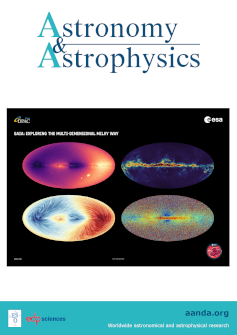热木星的全球流态
IF 5.8
2区 物理与天体物理
Q1 ASTRONOMY & ASTROPHYSICS
引用次数: 0
摘要
上下文。热木星和超热木星的大气动力学受到恒星辐射的影响,这影响了它们的大气环流和潜在的波结构。我们的目标是研究辐射和动力时间尺度的变化如何影响全球流动制度,大气环流效率,以及在热木星的策划样本中波浪结构的相互作用。特别是,我们探索了先前预测的全球流动状态的转变,其中增强的恒星辐射抑制了小尺度的波浪和涡流特征,这些特征进入超旋转射流,最终导致更简单的,日夜主导的流动。我们用THOR环流模型模拟了一组8个热木星,这些热木星的平衡温度从1100 K到2400 K不等。我们开发了一种基于小波的分析方法,将模拟风场分解为其底层波型,并通过分析实例对其进行了验证。作为对超热木星流动状态的初步探索,我们对WASP-121b进行了额外的模拟,其中平均分子量被设置为代表由氢原子主导的大气。我们的研究结果证实,增加恒星辐射会降低大气热再分配的效率,并削弱对维持超旋转至关重要的小尺度涡旋模式的贡献。随着平衡温度的升高,大尺度模式主导了大气环流,推动了从喷射主导的气流向日夜环流的转变。此外,通过人为降低平均分子量,可以部分恢复循环效率,并重新引入更复杂的多尺度流动模式。这些发现完善了我们对大气环流如何随着辐射增加和成分变化而演变的理解,为解释高温和超高温木星大气提供了更细致的框架。本文章由计算机程序翻译,如有差异,请以英文原文为准。
Global flow regimes of hot Jupiters
Context. The atmospheric dynamics of hot and ultrahot Jupiters are influenced by the stellar irradiation they receive, which shapes their atmospheric circulation and the underlying wave structures.Aims. We aim to investigate how variations in radiative and dynamical timescales influence global flow regimes, atmospheric circulation efficiency, and the interplay of wave structures across a curated sample of hot Jupiters. In particular, we explore a previously predicted transition in the global flow regime, where enhanced stellar irradiation suppresses the smaller-scale wave and eddy features that feed into superrotating jets and ultimately leads to simpler, day-to-night dominated flows.Methods. We simulated a suite of eight well-studied hot Jupiters with the THOR general circulation model, spanning equilibrium temperatures from about 1100 K to 2400 K. We developed a wavelet-based analysis method to decompose simulated wind fields into their underlying wave modes, which we validated on analytical examples. As a preliminary exploration of the flow regime of ultrahot Jupiters, we performed an additional simulation for WASP-121b, where the mean molecular weight was set to represent an atmosphere dominated by atomic hydrogen.Results. Our results confirm that increasing stellar irradiation diminishes the efficiency of atmospheric heat redistribution and weakens the contribution of smaller-scale eddy modes critical for sustaining superrotation. As equilibrium temperatures rise, large-scale modes dominate the atmospheric circulation, driving a transition from jet-dominated flows toward day-to-night circulation. Additionally, by artificially lowering the mean molecular weight, we partially restore circulation efficiency and reintroduce a more complex, multiscale flow pattern. These findings refine our understanding of how atmospheric circulation evolves with increasing irradiation and composition changes, offering a more nuanced framework for interpreting hot and ultrahot Jupiter atmospheres.
求助全文
通过发布文献求助,成功后即可免费获取论文全文。
去求助
来源期刊

Astronomy & Astrophysics
地学天文-天文与天体物理
CiteScore
10.20
自引率
27.70%
发文量
2105
审稿时长
1-2 weeks
期刊介绍:
Astronomy & Astrophysics is an international Journal that publishes papers on all aspects of astronomy and astrophysics (theoretical, observational, and instrumental) independently of the techniques used to obtain the results.
 求助内容:
求助内容: 应助结果提醒方式:
应助结果提醒方式:


